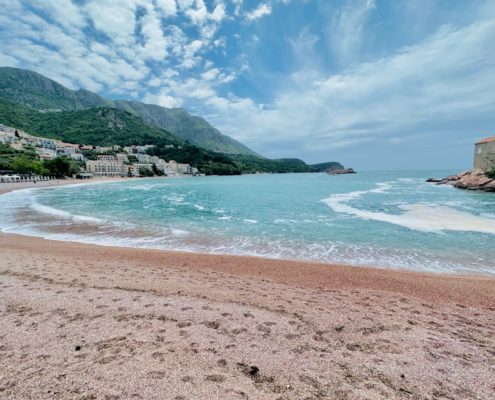Sveti Stefan is undoubtedly one of the most enchanting and iconic destinations along the Montenegrin Adriatic coast. This small offshore island is about 8 km south of Budva and covers an area of just under one and a half hectares and is connected to the mainland by a short causeway.
The architecture of Sveti Stefan is a real treat for the eyes. The town consists of old stone houses that are closely lined up and exude a unique charm. Each building tells its own story and contributes to the island’s historical heritage. The red roofs, narrow streets and steep stairs give Sveti Stefan a distinctive look. The island is connected to the shore by a narrow strip of sand and offers spectacular views of the turquoise waters of the Adriatic Sea.
Sveti Stefan used to be a picturesque fishing village with houses from the 15th century. There are several old churches on the island, including that of “Saint Stefan” (“Sveti Stefan”),which gave the island its name. Sveti Stefan Fortress achieved great rise as a trade and transport center due to its favorable location. It was of great strategic importance during the Venetian Republic and trade with Venice. However, at the end of the 19th and beginning of the 20th century, it soon lost its economic strength. Many residents have left the place. By 1954 only 20 people lived on the island.
In the 1960s, the island was finally renovated and opened as a luxury resort. The renovation was carried out in such a way that from the outside the buildings looked the same as before, while the interiors were richly decorated and converted into beautiful apartments. The alleys, roofs and house facades have retained their original character. This attractive and unusual hotel complex became a summer residence for Montenegrin noble families and quickly became a popular meeting place for film stars as well. A number of members of high society, including Sophia Loren, Sylvester Stallone and Claudia Schiffer, have already been guests there. Top politicians such as Willy Brandt, Helmut Kohl and Silvio Berlusconi were also among their visitors. A casino was also part of the complex, which gave Sveti Stefan the name “Adriatic Monaco”.
The island was leased by the Aman Group for 30 years from the state of Montenegro in 2007, after which it was renovated. In the summer of 2010, a gradual reopening began as “Aman Sveti Stefan” and the islet is 100 percent owned by the Aman Group. The island is not accessible to the general public, but only to residents and hotel guests. However, the facility has now been closed since 2020 for legal reasons.
Sveti Stefan is undoubtedly a magical place that uniquely combines the past and the present. The picturesque setting and rich history will enchant everyone, whether you are looking for relaxation, culture or adventure.
This post is also available in: German




